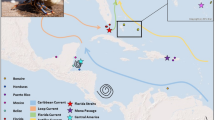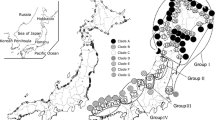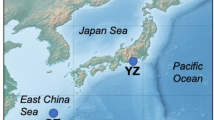Abstract
The life histories of species influence the connectivity between populations, for example the dispersal potential, fecundity, and population size. We compare the phylogeography and genetic connectivity of two sandy-beach crustaceans with contrasting dispersal potentials and population traits in Brazil, based on the 16S mitochondrial gene. While the ghost crab Ocypode quadrata possesses high fecundity, long-lived planktonic larvae, and lower population densities of adults, the isopod Excirolana braziliensis is a brooder with low fecundity and higher population densities. Phylogenetic analysis of haplotype networks yielded contrasting results for the two species. Four different lineages were observed for E. braziliensis, while O. quadrata showed a low genetic structure, sharing haplotypes over ~ 7,000 km. For the isopod, the two most frequent lineages (‘North A’ and ‘South A’ lineages) showed distribution range limits that agreed with the tropical-subtropical transition of 22°S, while the others were sympatric, less frequent, and uncommon. While the ‘North A’ showed high haplotype diversity with a high structure, the ‘South A’ showed shared haplotypes and low genetic structure. Our results suggest that the contrasting life histories affect the population connectivity and genetic structure. The genetic patterns of the two species should be considered in the management and conservation of sandy-beach ecosystems.



Similar content being viewed by others
References
Baeza, J. A. & M. S. Fuentes, 2013. Phylogeography of the shrimp Palaemon floridanus (Crustacea: Caridea: Palaemonidae): a partial test of meta-population genetic structure in the wider Caribbean. Marine Ecology 34: 381–393.
Barros, F., 2006. Ghost crabs as a tool for rapid assessment of human impacts on exposed sandy beaches. Biological Conservation 97: 399–404.
Barroso, R., M. Klautau, A. M. Solé-Cava, & P. C. Paiva, 2010. Eurythoe complanata (Polychaeta: Amphinomidae), the ‘cosmopolitan’ fireworm, consists of at least three cryptic species. Marine Biology 157: 69–80.
Barroso, C. X., T. M. D. C. Lotufo, L. E. A. Bezerra & H. Matthews-Cascon, 2016. A biogeographic approach to the insular marine “prosobranch” gastropods from the southwestern Atlantic Ocean. Journal of Molluscan Studies 82: 558–563.
Bermingham, E. & C. Moritz, 1998. Comparative phylogeography: concepts and applications. Molecular Ecology 7: 367–369.
Bowen, B. W., M. R. Gaither, J. D. DiBattista, M. Iacchei, K. R. Andrews, W. S. Grant, R. J. Toonen & J. C. Briggs, 2016. Comparative phylogeography of the ocean planet. Proceedings of the National Academy of Sciences 113: 7962–7969.
Bradbury, I., B. Laurel, P. Snelgrove, P. Bentzen & S. Campana, 2008. Global patterns in marine dispersal estimates: the influence of geography, taxonomic category and life history. Proceedings of the Royal Society B: Biological Sciences 275: 1803–1809.
Cardoso, R. S., C. A. M. Barboza, V. B. Skinner & T. M. B. Cabrini, 2016. Crustaceans as ecological indicators of metropolitan sandy beaches health. Ecological Indicators 62: 154–162.
Dalongeville, A., M. Andrello, D. Mouillot, C. Albouy & S. Manel, 2015. Ecological traits shape genetic diversity patterns across the Mediterranean Sea: a quantitative review on fishes. Journal of Biogeography. https://doi.org/10.1111/jbi.12669.
Darriba, D., G. L. Taboada, R. Doallo & D. Posada, 2012. JModelTest 2: more models, new heuristics and parallel computing. Nature Methods Nature Publishing Group 9: 772.
Dawson, M., C. Hays, R. Grosberg & P. Raimondi, 2014. Dispersal potential and population genetic structure in the marine intertidal of the eastern North Pacific. Ecological Monographs 84: 435–456.
Dawson, M. N., 2014. Natural experiments and meta-analyses in comparative phylogeography. Journal of Biogeography 41: 52–65.
Dawson, M. N., P. H. Barber, L. I. González-Guzmán, R. J. Toonen, J. E. Dugan & R. K. Grosberg, 2011. Phylogeography of Emerita analoga (Crustacea, Decapoda, Hippidae), an eastern Pacific Ocean sand crab with long-lived pelagic larvae. Journal of Biogeography 38: 1600–1612.
DeBiasse, M. B., V. P. Richards, M. S. Shivji & M. E. Hellberg, 2016. Shared phylogeographical breaks in a Caribbean coral reef sponge and its invertebrate commensals. Journal of Biogeography 43: 2136–2146.
Defeo, O. & A. McLachlan, 2005. Patterns, processes and regulatory mechanisms in sandy beach macrofauna: a multi-scale analysis. Marine Ecology Progress Series 295: 1–20.
Defeo, O., A. Brazeiro, A. de Alava & G. Riestra, 1997. Is sandy beach macrofauna only physically controlled? Role of substrate and competition in isopods. Estuarine, Coastal and Shelf Science 45: 453–462.
Defeo, O., A. McLachlan, D. S. Schoeman, T. A. Schlacher, J. Dugan, A. Jones, M. Lastra & F. Scapini, 2009. Threats to sandy beach ecosystems: a review. Estuarine, Coastal and Shelf Science 81: 1–12.
Diaz, H. & J. D. Costlow, 1972. Larval development of Ocypode quadrata (Brachyura: Crustacea) under laboratory conditions. Marine Biology 15: 120–131.
Drummond, A. J., A. Rambaut, B. Shapiro & O. G. Pybus, 2005. Bayesian coalescent inference of past population dynamics from molecular sequences. Molecular Biology and Evolution 22: 1185–1192.
Drummond, A. J., M. A. Suchard, D. Xie & A. Rambaut, 2012. Bayesian phylogenetics with BEAUti and the BEAST 1.7. Molecular Biology and Evolution 29: 1969–1973.
Eberl, R., M. Mateos, R. K. Grosberg, C. A. Santamaria & L. A. Hurtado, 2013. Phylogeography of the supralittoral isopod Ligia occidentalis around the point conception marine biogeographical boundary. Journal of Biogeography 40: 2361–2372.
Excoffier, L. & H. E. L. Lischer, 2010. Arlequin suite ver 3.5: a new series of programs to perform population genetics analyses under Linux and Windows. Molecular Ecology Resources 10: 564–567.
Floeter, S. R., L. A. Rocha, D. R. Robertson, J. C. Joyeux, W. F. Smith-Vaniz, P. Wirtz, A. J. Edwards, J. P. Barreiros, C. E. L. Ferreira, J. L. Gasparini, A. Brito, J. M. Falcón, B. W. Bowen & G. Bernardi, 2008. Atlantic reef fish biogeography and evolution. Journal of Biogeography 35: 22–47.
Floyd, R., E. Abebe, A. Papert & M. Blaxter, 2002. Molecular barcodes for soil nematode identification. Molecular ecology 11: 839–850.
Glynn, P. W., D. M. Dexter & T. E. Bowman, 1975. Excirolana braziliensis, a Pan-American sand beach isopod: taxonomic status, zonation and distribution. Journal of Zoology 175: 509–521.
Gutiérrez-García, T. A. & E. Vázquez-Domínguez, 2011. Comparative phylogeography: designing studies while surviving the process. BioScience 61: 857–868.
Hamasaki, K., C. Iizuka, T. Sanda, H. Imai & S. Kitada, 2017. Phylogeny and phylogeography of the land hermit crab Coenobita purpureus (Decapoda: Anomura: Coenobitidae) in the Northwestern Pacific Region. Marine Ecology 38: 1–17.
Haye, P. A., N. I. Segovia, N. C. Muñoz-Herrera, F. E. Gálvez, A. Martínez, A. Meynard, M. C. Pardo-Gandarillas, E. Poulin & S. Faugeron, 2014. Phylogeographic structure in benthic marine invertebrates of the southeast Pacific coast of Chile with differing dispersal potential. PLoS ONE 9: e88613.
Ho, S. Y. W. & B. Shapiro, 2011. Skyline-plot methods for estimating demographic history from nucleotide sequences. Molecular Ecology Resources 11: 423–434.
Hoffman, J. I., A. Clarke, K. Linse & L. S. Peck, 2011. Effects of brooding and broadcasting reproductive modes on the population genetic structure of two Antarctic gastropod molluscs. Marine Biology 158: 287–296.
Hurtado, L. A., E. J. Lee & M. Mateos, 2013. Contrasting phylogeography of sandy vs. rocky supralittoral isopods in the megadiverse and geologically dynamic Gulf of California and adjacent areas. PLoS ONE 8: e67827.
Hurtado, L. A., E. J. Lee, M. Mateos & S. Taiti, 2014. Global diversification at the harsh sea-land interface: mitochondrial phylogeny of the supralittoral isopod genus Tylos (Tylidae, Oniscidea). PLoS ONE 9: e94081.
Hurtado, L. A., M. Mateos, G. Mattos, S. Liu, P. A. Haye & P. C. Paiva, 2016. Multiple transisthmian divergences, extensive cryptic diversity, occasional long-distance dispersal, and biogeographic patterns in a marine coastal isopod with an amphi-American distribution. Ecology and Evolution 6: 7794–7808.
Hurtado, L. A., M. Mateos & S. Liu, 2017. Phylogeographic patterns of a lower intertidal isopod in the Gulf of California and the Caribbean and comparison with other intertidal isopods. Ecology and Evolution 7: 346–357.
Jackson, L. F., M. J. Smale & P. F. Berry, 1991. Ghost crabs of the genus Ocypode (Decapoda, Brachyura, Ocypodidae) of the East Coast of South Africa. Crustaceana 61: 280–286.
Jaramillo, E., 1982. Taxonomy, natural history and zoogeography of sand beach isopods from the coast of southern Chile. Studies on Neotropical Fauna and Environment 17: 175–194.
Laurenzano, C., F. L. M. Mantelatto & C. D. Schubart, 2013. South American homogeneity versus Caribbean heterogeneity: population genetic structure of the western Atlantic fiddler crab Uca rapax (Brachyura, Ocypodidae). Journal of Experimental Marine Biology and Ecology 449: 22–27.
Lee, T. R. C., S. Y. W. Ho, G. D. F. Wilson & N. Lo, 2014. Phylogeography and diversity of the terrestrial isopod Spherillo grossus (Oniscidea: Armadillidae) on the Australian East Coast. Zoological Journal of the Linnean Society 170: 297–309.
Lessios, H. A., J. Kane & D. R. Robertson, 2003. Phylogeography of the pantropical sea urchin Tripneustes: contrasting patterns of population structure between oceans. Evolution 57: 2026–2036.
Librado, P. & J. Rozas, 2009. DnaSP v5: a software for comprehensive analysis of DNA polymorphism data. Bioinformatics 25: 1451–1452.
Lozoya, J. P., J. Gómez & O. Defeo, 2010. Modelling large-scale effects of estuarine and morphodynamic gradients on distribution and abundance of the sandy beach isopod Excirolana armata. Estuarine, Coastal and Shelf Science 87: 472–478.
Lucrezi, S. & T. A. Schlacher, 2014. The ecology of ghost crabs. Oceanography and Marine Biology: An Annual Review 52: 201–256.
Ludt, W. B. & L. A. Rocha, 2015. Shifting seas: the impacts of Pleistocene sea-level fluctuations on the evolution of tropical marine taxa. Journal of Biogeography 42: 25–38.
Luiz, O. J., J. S. Madin, D. R. Robertson, L. A. Rocha, P. Wirtz & S. R. Floeter, 2012. Ecological traits influencing range expansion across large oceanic dispersal barriers: insights from tropical Atlantic reef fishes. Proceedings of the Royal Society B 279: 1033–1040.
Marko, P. B. & M. W. Hart, 2011. The complex analytical landscape of gene flow inference. Trends in Ecology and Evolution 26: 448–456.
Martínez, G. & O. Defeo, 2006. Reproductive biology of the isopod Excirolana braziliensis at the southern edge of its geographical range. Helgoland Marine Research 60: 273–280.
Mendonça, F. F., C. Oliveira, O. B. F. Gadig & F. Foresti, 2013. Diversity and genetic population structure of the Brazilian sharpnose shark Rhizoprionodon lalandii. Aquatic Conservation: Marine and Freshwater Ecosystems 23: 850–857.
Miller, M. A., W. Pfeiffer, & T. Schwartz, 2010. Creating the CIPRES science gateway for inference of large phylogenetic trees. 2010 Gateway Computing Environments Workshop (GCE). IEEE 2010: 1–8.
Neves, F., L. Colling, P. Pereira & C. E. Bemvenuti, 2006. Daily variation of macrobenthic fauna on an exposed sandy beach of Rio Grande do Sul, Brazil. Journal of Coastal Research SI 39: 1225–1228.
Neves, L., P. Silva & C. Bemvenuti, 2007. Zonation of benthic macrofauna on Cassino Beach, southernmost Brazil. Brazilian Journal of Oceanography 55: 293–307.
Nunes, F. L. D., A. Van Wormhoudt, L. Faroni-perez & I. R. D. Ifremer, 2017. Phylogeography of the reef-building polychaetes of the genus Phragmatopoma in the western Atlantic Region. Journal of Biogeography 44: 1612–1625.
Nunes, F., R. D. Norris & N. Knowlton, 2009. Implications of isolation and low genetic diversity in peripheral populations of an amphi-Atlantic coral. Molecular Ecology 18: 4283–4297.
Palumbi, S. R., A. Martin, S. Romano, W. O. McMillan, L. Stice, & G. Grabowski, 1991. The simple fool’s guide to PCR. University of Hawaii., 1–45.
Palumbi, S. R. & R. R. Warner, 2003. Why Gobies Are Like Hobbits. Science 299: 51–52.
Paradis, E., 2010. PEGAS: an R package for population genetics with an integrated-modular approach. Bioinformatics 26: 419–420.
Pelc, R. A., R. R. Warner & S. D. Gaines, 2009. Geographical patterns of genetic structure in marine species with contrasting life histories. Journal of Biogeography 36: 1881–1890.
Peña-Toribio, A., E. López-López, J. J. Flores-Martínez, V. Sanchez-Cordero, Z. Gómez-Lunar & E. A. Ruiz, 2017. Genetic diversity of the atlantic ghost crab Ocypode quadrata (Decapoda: Ocypodidae) in two beaches with different anthropogenic disturbance in the north coast of Veracruz, Mexico. Tropical Conservation Science 10: 1–9.
Pombo, M. & A. Turra, 2013. Issues to be considered in counting burrows as a measure of atlantic ghost crab populations, an important bioindicator of sandy beaches. PLoS ONE 8: e83792.
R Core Team, 2015. R: a language and environment for statistical computing. R Foundation for Statistical Computing, Vienna, Austria. http://www.r-project.org.
Rambaut, A., M. Suchard, D. Xie, & A. Drummond, 2014. Tracer v1.6. http://beast.bio.ed.ac.uk/Tracer.
Rangel, C. A. & L. F. Mendes, 2009. Review of blenniid fishes from Fernando de Noronha Archipelago, Brazil, with description of a new species of Scartella (Teleostei: Blenniidae). Zootaxa 2006: 51–61.
Ribetti, V. L. & D. Roccatagliata, 2006. Redescription of Excirolana armata (Dana, 1853) and synonymy of Cirolana argentina Giambiagi, 1930 (Crustacea: Isopoda: Cirolanidae). Proceedings of the Biological Society of Washington 119: 1–14.
Richards, V. P., J. D. Thomas, M. J. Stanhope & M. S. Shivji, 2007. Genetic connectivity in the Florida reef system: comparative phylogeography of commensal invertebrates with contrasting reproductive strategies. Molecular Ecology 16: 139–157.
Rodríguez-Rey, G. T., A. Carvalho Filho, M. E. De Araújo & A. M. Solé-Cava, 2018. Evolutionary history of Bathygobius (Perciformes: Gobiidae) in the Atlantic biogeographic provinces: a new endemic species and old mitochondrial lineages. Zoological Journal of the Linnean Society 182: 360–384.
Santamaria, C. A., M. Mateos & L. A. Hurtado, 2014. Diversification at the narrow sea-land interface in the Caribbean: phylogeography of endemic supralittoral Ligia isopods. Frontiers in Ecology and Evolution 2: 1–15.
Schlacher, T. A., R. De Jager & T. Nielsen, 2011. Vegetation and ghost crabs in coastal dunes as indicators of putative stressors from tourism. Ecological Indicators 11: 284–294.
Schlacher, T. A., S. Lucrezi, R. M. Connolly, C. H. Peterson, B. L. Gilby, B. Maslo, A. D. Olds, S. J. Walker, J. X. Leon, C. M. Huijbers, M. A. Weston, A. Turra, G. A. Hyndes, R. A. Holt & D. S. Schoeman, 2016. Human threats to sandy beaches: a meta-analysis of ghost crabs illustrates global anthropogenic impacts. Estuarine, Coastal and Shelf Science 169: 56–73.
Soares, A., 2003. Sandy beach morphodynamics and macrobenthic communities in temperate, subtropical and tropical regions: a macroecological approach. University of Port Elizabeth, PhD thesis. http://hdl.handle.net/10948/293.
Souza, J. & N. Gianuca, 1995. Zonation and seasonal variation of the intertidal macrofauna on a sandy beach of Paraná State, Brazil. Scientia Marina 59: 103–111.
Spalding, M. D., H. E. Fox, G. R. Allen, N. Davidson, Z. A. Ferdaña, M. Finlayson, B. S. Halpern, M. A. Jorge, A. Lombana, S. A. Lourie, K. D. Martin, E. McManus, J. Molnar, C. A. Recchia & J. Robertson, 2007. Marine ecoregions of the world: a bioregionalization of coastal and shelf areas. BioScience 57: 573–583.
Sponer, R. & H. A. Lessios, 2009. Mitochondrial phylogeography of the intertidal isopod Excirolana braziliensis on the two sides of the Isthmus of Panama. Smithsonian Contributions to the Marine Sciences 38: 219–228.
Tamura, K., G. Stecher, D. Peterson, A. Filipski & S. Kumar, 2013. MEGA6: molecular evolutionary genetics analysis version 6.0. Molecular Biology and Evolution 30: 2725–2729.
Terossi, M. & F. L. Mantelatto, 2012. Morphological and genetic variability in Hippolyte obliquimanus Dana, 1852 (Decapoda, Caridea, Hippolytidae) from Brazil and the Caribbean Sea. Crustaceana 85: 685–712.
Tourinho, J. L., A. Márquez, E. Celentano & O. Defeo, 2016. A new evolutionary unit in the Excirolana braziliensis species complex. Brazilian Journal of Oceanography 64: 197–202.
Varela, A. I. & P. A. Haye, 2012. The marine brooder Excirolana braziliensis (Crustacea: Isopoda) is also a complex of cryptic species on the coast of Chile. Revista Chilena de Historia Natural 85: 495–502.
Veloso, V. G., G. Neves & L. A. Capper, 2011. Sensitivity of a cirolanid isopod to human pressure. Ecological Indicators 11: 782–788.
Yeo, D. C. J., H.-T. Shih, R. Meier & P. K. L. Ng, 2007. Phylogeny and biogeography of the freshwater crab genus Johora (Crustacea: Brachyura: Potamidae) from the Malay Peninsula, and the origins of its insular fauna. Zoologica Scripta 36: 255–269.
Acknowledgements
We are grateful to Andre Lanna, Carlos Barboza, Elinia Lopes, and Viviane Monteiro for providing samples; María Chaumet for helping with the English of the draft; and Janet Reid for the final review as native English speakers. We thank Dr Cecile Fauvelot and two anonymous reviewers for their constructive inputs during preparation of this manuscript. The research was conducted under permits from the Brazilian government [Instituto Chico Mendes de Conservação da Biodiversidade/Sistema de Autorização e Informação em Biodiversidade (ICMBio/SISBIO) #10238-1 and #33628-2]. This is part of the PhD Thesis of GM, with CAPES (2012–14) and FAPERJ (2014–16) (E-26/100.230/2014) scholarships. GM is supported by a postdoctoral research fellowship from FUNBIO, VCS is supported by a postdoctoral research fellowship from CAPES, and PCP is supported by a research fellowship awarded by CNPq.
Author information
Authors and Affiliations
Corresponding author
Additional information
Handling editor: Cecile Fauvelot
Electronic supplementary material
Below is the link to the electronic supplementary material.
Rights and permissions
About this article
Cite this article
Mattos, G., Seixas, V.C. & Paiva, P.C. Comparative phylogeography and genetic connectivity of two crustacean species with contrasting life histories on South Atlantic sandy beaches. Hydrobiologia 826, 319–330 (2019). https://doi.org/10.1007/s10750-018-3744-3
Received:
Revised:
Accepted:
Published:
Issue Date:
DOI: https://doi.org/10.1007/s10750-018-3744-3




